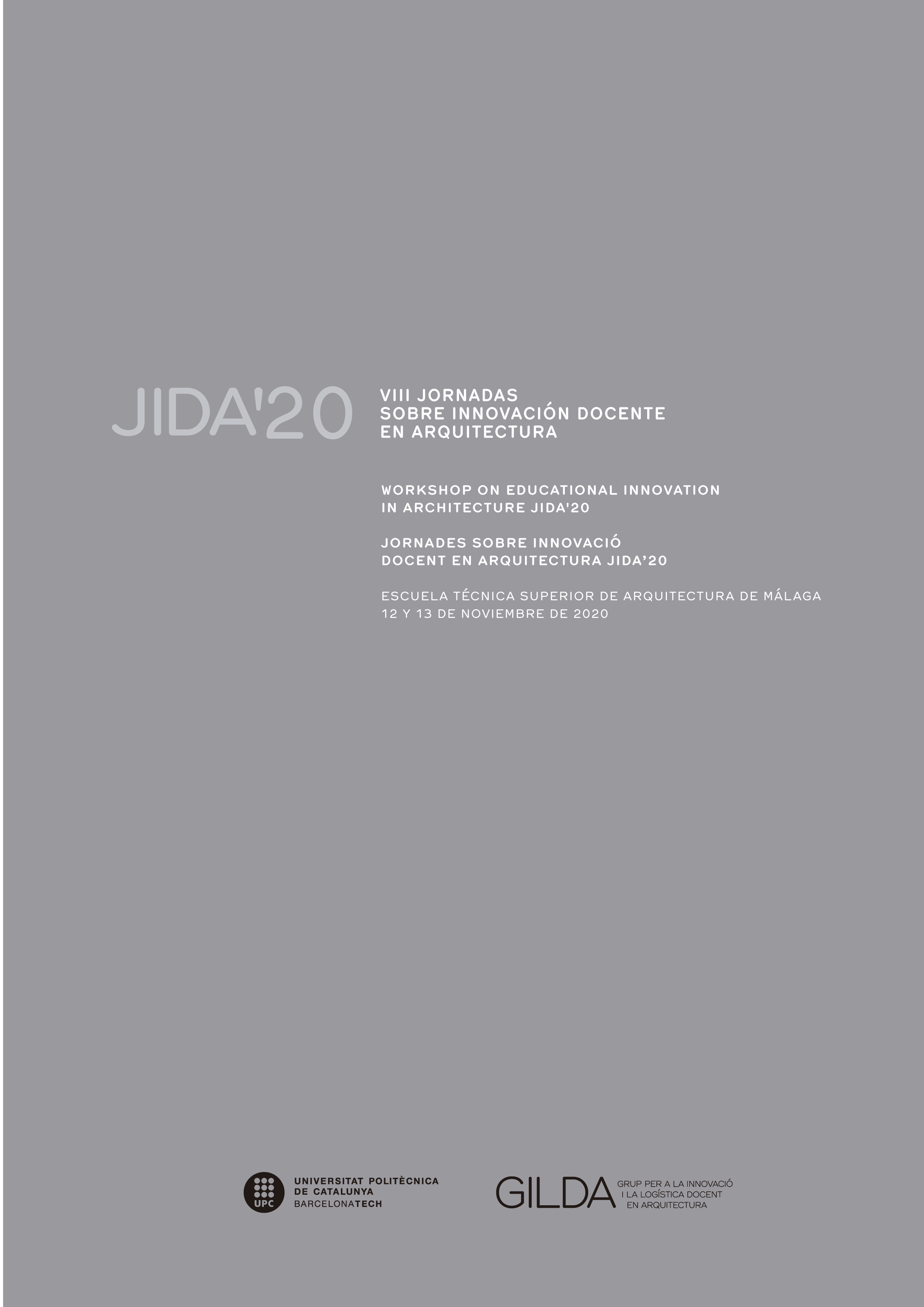Participatory urbanism for teaching on public space, the confinement arrived
DOI:
https://doi.org/10.5821/jida.2020.9447Abstract
Citizen engagement in the production of urban space is an accepted need, driven by the global as well as many local agendas. This communication has two main goals: first to describe a design adaptation of a method that comes from social sciences, used to develop a research-project process grounded in the territory that allows collaborating with its people. Second, to present an initial evaluation of this method. This inclusive process, developed within the framework of an optional subject in the Fundamentals of Architecture degree, has sought to introduce complexity and socio-environmental responsibility among the students as well as generating transmission of bi-directional knowledge academia-society, in a course disrupted by the pandemic.
References
BAUMAN, Zygmunt.(2015) Modernidad lÃquida. Buenos Aires:Fondo de cultura económica.
BORJA, Jordi y MUXÃ, Zaida. (2003). El espacio público: ciudad y ciudadanÃa. Barcelona: Electra.
CLARET VELIZ, Arnoldo. (2009). Proyectos Comunitarios en Investigación Cualitativa. Caracas: dirección de Artes Graficas, MPPD.
COL-LECTIU PUNT 6 (2019). Urbanismo Feminista. Por una tranformación radical de los espacios de la vida. Barcelona:Virus Editorial
DE WANDELER, Koen. (2015). Learning tactical urbanism: an action-research workshop in Brussels. Towards a new urbanity: places for urban coherence, , p. 246-263.
GEHL, Jan. (2006). La humanización del espacio urbano: la vida social entre los edificios (Vol. 9). Reverté.
GONZÃLEZ, Ricardo Carcelén; MARTÃN, Fernando Miguel GarcÃa. Learn 2 teach, teach 2 learn. Aprendizaje-Servicio e intercambio de roles en Arquitectura. VII Jornades sobre Innovació Docent en Arquitectura (JIDA '19), Escuela Técnica Superior de Arquitectura de Madrid, 14 y 15 de Noviembre de 2019 [63] http://dx.doi.org/10.5821/jida.2019.8305
HARAWAY, Donna. (1995). Ciencia, cyborgs y mujeres. Madrid, Cátedra.
HIRIA KOLEKTIBOA (2010). Manual de análisis urbano. Género y vida cotidiana. Manual metodológico. Vitoria-Gasteiz: Departamento de Vivienda, Obras Públicas y Transporte del Gobierno Vasco.
JACOBS, Jane (2011(1961)). Muerte y vida de las grandes ciudades. Madrid: Capin Swing Libros.
LEADING CITIES. (2012) Co-creating cities. Defining co-creation as a mean of citizen engagement, https://leadingcities2014.files.wordpress.com/2014/02/co-creation-formatted-draft-6.pdf [consulta: 10de Diciembre de 2019]
LOMBARD, Melanie. (2014). Constructing ordinary places: Place-making in urban informal settlements in Mexico. Progress in Planning, vol. 94, p. 1-53.
MARKUSEN, Ann; GADWA, Anne. (2010). Creative placemaking. Washington, DC: National Endowment for the Arts.
MARTINEZ MIGUELEZ, Miguel. (2004). Ciencia y Arte en la metodologÃa cualitativa. México: Trillas
MARTÃNEZ, Begoña.,MARTÃNEZ, Isabel.,ALONSO, Israel. y Gezuraga, Monike. (2013). El Aprendizajeâ€Servicio, una oportunidad para avanzar en la innovación educativa dentro de la Universidad del PaÃs Vasco. Tendencias Pedagógicas, 21, 99â€117.
MORIN, Edgar (2011 (1990)). Introducción al pensamiento complejo. Barcelona, Gedisa.
MUXÃ, Zaida; CASANOVAS, Roser; CIOCOLETTO, Adriana; FONSECA Marta y VALDIVIA, Blanca (2011) ‘¿Qué aporta la perspectiva de género al urbanismo?’, Revista Feminismos nº 17 , pp. 105-129.
NACIONES UNIDAS (2015): Transformar nuestro mundo: la Agenda 2030 para el Desarrollo Sostenible. Resolución aprobada por la Asamblea General el 25 deseptiembre de 2015. A/RES/70/1, 21 de octubre
RODRÃGUEZ-VILLASANTE, Tomás; Montañés, Manuel & MartÃ, Joel. (2002). La investigación social participativa: Construyendo CiudadanÃa. Barcelona: El Viejo Topo.
STEFFENS, Kurt. (2013). Urbanismo táctico, 3 casos latinoamericanos. Santiago: Ciudad Emergente.
TELLERIA ANDUEZA, Koldo. (2014). "Lurralde bat; hainbat hizkuntza, hainbat modu." Bat: Soziolinguistika aldizkaria 90: 25-40.
TELLERIA ANDUEZA, Koldo (2012).â€Decisiones a pequeña escala, grandes cambios†en VV.AA. Urbanismo inclusivo. Las calles tienen género. Vitoria-Gasteiz. Eusko Jaurlaritzaren Argitalpen Zerbitzu Nagusia. Servicio Central de Publicaciones del Gobierno Vasco.
VALDIVIA, Blanca. (2018). Del Urbanismo andrcéntrico a la ciudad cuidadora. Hábitat y Sociedad nº11, 65-84.



















